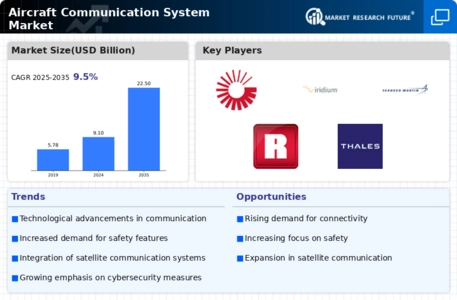Aircraft Communication System Size
Aircraft Communication System Market Growth Projections and Opportunities
The aircraft communication system market is shaped by various factors that influence its growth and development. Firstly, advancements in aviation technology and the increasing demand for air travel contribute to the expansion of the aircraft communication system market. As the global aviation industry continues to grow, there is a corresponding need for reliable and efficient communication systems onboard aircraft to ensure safe and seamless communication between pilots, air traffic controllers, and ground personnel. This demand is driven by the need for enhanced safety, improved operational efficiency, and compliance with regulatory requirements governing communication standards in aviation.
Secondly, regulatory mandates and industry standards play a significant role in shaping the aircraft communication system market. Aviation authorities such as the Federal Aviation Administration (FAA) and the European Aviation Safety Agency (EASA) impose regulations and guidelines governing communication systems and equipment installed on aircraft to ensure compliance with safety, security, and interoperability requirements. Compliance with regulatory standards is essential for aircraft manufacturers, airlines, and communication system providers to obtain certification and approval for their products, driving adherence to established communication protocols and standards in the market.
Furthermore, technological advancements drive innovation and product development in the aircraft communication system market. The evolution of communication technologies, including satellite communication, data link systems, and voice communication systems, enables the development of advanced communication solutions with improved reliability, bandwidth, and connectivity capabilities. Aircraft communication system providers invest in research and development to develop next-generation communication systems that meet the evolving needs of the aviation industry, including enhanced data exchange, real-time communication, and integration with air traffic management systems.
Moreover, market trends in the commercial aviation sector influence the demand for aircraft communication systems. With the increasing adoption of digital flight deck technologies, automation, and connectivity solutions in modern aircraft, there is a growing need for advanced communication systems that support data exchange, cockpit connectivity, and inflight connectivity services. Airlines seek communication systems that enable seamless integration with flight management systems, electronic flight bags, and onboard entertainment systems to enhance the passenger experience and operational efficiency.
Additionally, the rise of air traffic and congestion in busy airspace regions drives demand for aircraft communication systems that support efficient air traffic management and coordination. Air traffic controllers rely on communication systems to maintain safe separation between aircraft, issue instructions to pilots, and provide real-time updates on weather conditions, airspace restrictions, and traffic flow. Communication system providers develop solutions that enable reliable and secure communication between aircraft and ground-based control centers, contributing to the safe and efficient operation of airspace systems.
Furthermore, economic factors such as airline profitability, fleet expansion, and budget constraints influence the investment decisions of airlines and aircraft operators in communication systems. Airlines evaluate the cost-effectiveness, reliability, and performance of communication systems when selecting equipment for their aircraft fleets, considering factors such as initial acquisition costs, lifecycle costs, and return on investment. Communication system providers compete on price, quality, and features to cater to the diverse needs and budgetary constraints of airline customers in the competitive aviation market.










Leave a Comment